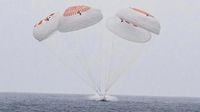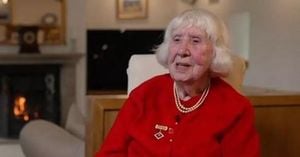NASA astronaut Anne McClain, a Spokane native and U.S. Army Colonel, has once again etched her name into the annals of space exploration, returning to Earth after commanding the SpaceX Crew-10 mission to the International Space Station (ISS). McClain, along with fellow NASA astronaut Nichole Ayers, Japan's Takuya Onishi, and Russia's Kirill Peskov, splashed down safely in the Pacific Ocean off the coast of Southern California on Saturday, August 9, 2025, at 8:33 a.m. Pacific Time (11:33 a.m. Eastern Time), marking a triumphant conclusion to a mission filled with both technical achievement and international cooperation.
The Crew-10 mission, which launched in March, was no ordinary rotation. The team was dispatched to relieve astronauts Suni Williams and Butch Wilmore, who found themselves stranded aboard the ISS for nine months after the Boeing Starliner capsule they arrived in suffered thruster problems and helium leaks. According to AP, NASA deemed it too risky to return Williams and Wilmore in the malfunctioning Starliner, opting instead to bring them home in a SpaceX capsule after Crew-10 arrived. Wilmore, a NASA veteran of 25 years, announced his retirement shortly after his return.
For McClain and her fellow travelers, the journey was both a personal and collective milestone. The mission lasted a total of 148 days round-trip, with all but two of those days spent aboard the ISS. During their tenure in microgravity, Crew-10 conducted groundbreaking research, performed essential station maintenance, and even participated in educational downlinks—such as the live session McClain held with students at her alma mater, Gonzaga Preparatory School, in May. The crew orbited the Earth a staggering 2,368 times and traveled more than 63 million miles during their 146 days at the space station, as noted by Dina Contella, deputy manager for NASA's ISS program.
On August 5, just days before their return, Crew-10 participated in a changing of the guard ceremony with Crew-11, who had arrived the previous week. The moment was reflective, with gratitude emerging as a central theme. "All of us are keenly aware that we may never get to do this again," McClain said during the ceremony, according to The Spokesman-Review. "We’ve been very pensive over the last few days, understanding what we have all got to be a part of. And we know that there’s some tumultuous times on Earth. … We want this mission, our mission, to be a reminder of what people can do when we work together, when we explore together."
The return journey was as dramatic as it was precise. After undocking from the ISS while orbiting roughly 260 miles above Jakarta, Indonesia, the autonomous SpaceX Dragon capsule—aptly named Endurance—began its more than 17-hour trip back to Earth. The spacecraft started its descent at an orbiting speed of about 17,500 mph, initiating an 18-minute deorbit burn that slowed the craft and set it on a collision course with Earth's atmosphere. As the capsule re-entered, temperatures soared to as high as 3,500 degrees Fahrenheit due to friction, creating a fiery plasma envelope that temporarily severed communications for about seven minutes, a standard occurrence during re-entry, according to NASA.
At approximately 18,000 feet above the Pacific, a series of parachutes deployed, followed by four larger chutes at about 6,500 feet, further slowing the capsule's descent. The crew experienced gravitational forces up to 5-Gs before finally splashing down at a speed of around 16 mph. Waiting for them was the SpaceX recovery ship Shannon, which has become a familiar sight in recent years, having been used in more than 20 recovery missions since 2019. The ship, equipped with a specialized crane, helipad, medical experts, and technical crews, ensured the astronauts’ safe and swift extraction from the capsule.
This splashdown was not only a personal milestone for the crew but also a historic event for NASA. It marked the agency’s first Pacific splashdown in 50 years, harkening back to the Apollo-Soyuz mission in 1975, which was the first crewed international space mission involving Americans and Soviets. As AP reported, it was also just the third SpaceX splashdown with people aboard in the Pacific. Earlier in 2025, SpaceX made the decision to shift splashdown operations from Florida to California, aiming to minimize the risk of debris falling over populated areas.
The significance of the mission extended beyond technical achievements. As McClain noted, the ISS—set to celebrate 25 years of continuous human presence in November—remains a beacon of international cooperation amid shifting geopolitical landscapes. "I truly believe that this is one of the biggest feats of cooperation that humans have ever accomplished. It takes people from every country, all around the world, every single day, showing up to support this mission, to make it happen," McClain reflected. She pointed out that the ISS was conceived during a period of high political tension, yet visionaries from around the globe managed to turn the dream into reality. "There’s a lot of people that would say ‘That’s not going to be possible,’" McClain said. "But all it took was visionaries from all around the world to work together, to have a mustard seed of faith that something like this could be done when we work together."
After the splashdown, the crew was assisted out of the Endurance, feeling the pull of Earth's gravity for the first time in over five months. McClain, ever the consummate astronaut, flashed several smiles and raised her arms triumphantly as she exited the capsule, clearly relishing the moment. According to AP, the crew was eager to enjoy simple earthly pleasures—hot showers, burgers, and even doing nothing for a couple of days. After initial medical checks on the recovery ship, the astronauts were flown by helicopter to meet a NASA aircraft bound for Houston for further evaluation and reunions with loved ones.
The mission also highlighted the close-knit nature of the astronaut community. McClain, now with 352 days in space and three spacewalks totaling nearly 19 hours, commemorated her cosmic reunion with retired astronaut Peggy Whitson—who holds the record for the most days in space by an American—on social media, writing, "When you reach your goals, send the elevator back down!" McClain was selected as an astronaut in 2013 by a committee that included Whitson, while McClain herself later helped select Ayers in 2021, underscoring the generational bonds that sustain NASA’s human spaceflight program.
Looking ahead, McClain may well add to her already impressive resume as a member of the Artemis program, which aims to return humans to the Moon. For now, though, she expressed simple gratitude for being back on "the greatest planet in the solar system." As she quipped with a smile, "We’ve checked."
With each mission, NASA’s astronauts remind us of the power of vision, teamwork, and perseverance—qualities that shine brightest when humanity dares to reach beyond its grasp.




